A common classification identifies four types of online searchers. This is the most widely used system for categorizing user intent. These categories can also be referred to as “micro-moments,” which define the immediate need—what the user seeks to achieve when they enter a query into the search box.
Informational intent (informational)
This is the most common type of query entered into search engines. People in this group are seeking more knowledge on a variety of topics—such as recipes, tutorials, definitions, or general information, including topics like SEO or AI. In these cases, Google often provides matching search results, along with specific rich snippets (result extensions) or snippets containing the answer.
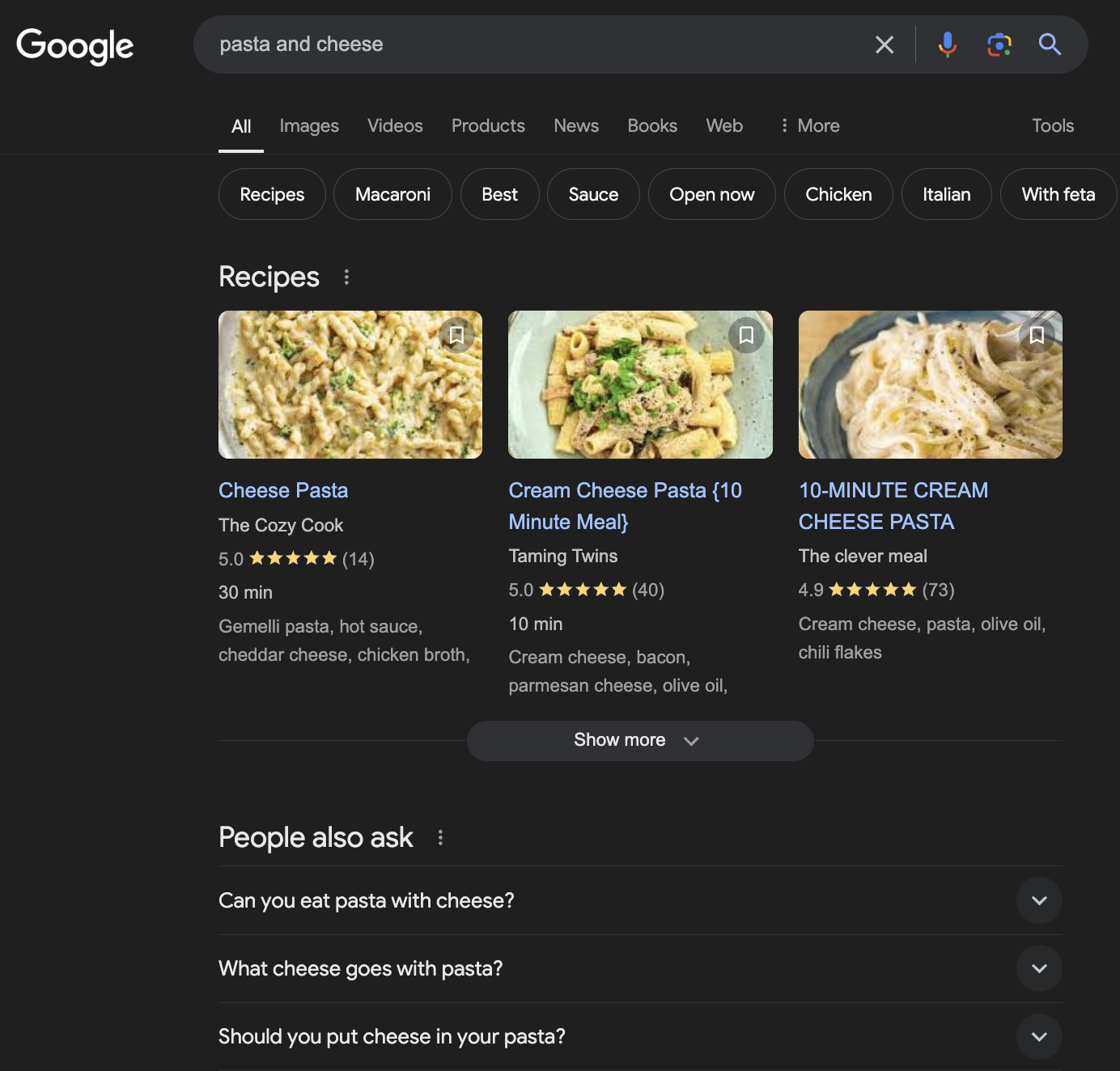
For example – for the phrase pasta and cheese we will get a result with recipes and answers to related questions.
Users with this clear intention know their goal and need to find the relevant website address through the search engine. These are often branded queries, such as searches for a company name or a specific tool. The source of these queries can also come from other advertising channels, like radio or TV, where the product or service names were mentioned.
An example of such a phrase is SENUTO or Adidas.
Transactional (transactional)
Intensity.
This is the most relevant search intent for e-commerce. These are users browsing the internet with the intention of purchasing an item or ordering a service. Often, when they enter a query, they know exactly what product they want to buy, so they are looking for a store or a review.
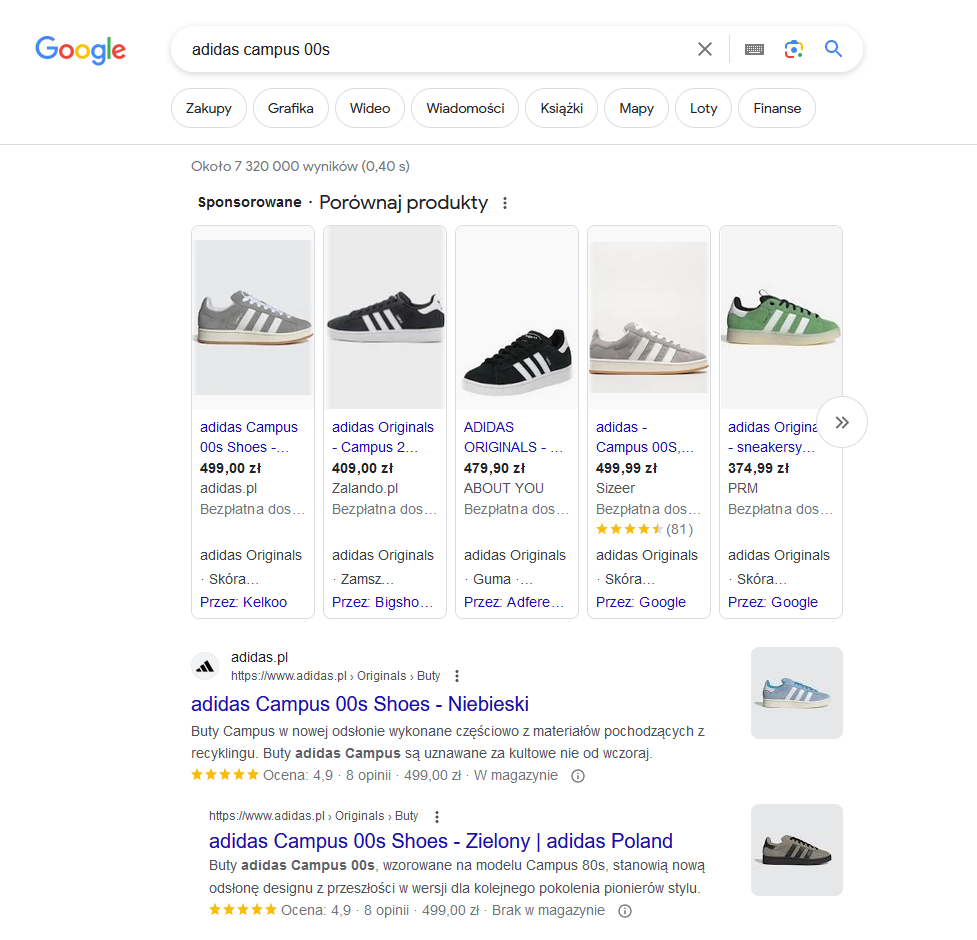
In the above example, the search results clearly answer the intent of the product query. The user gets images, a product comparison or a set of reviews.
Intent of advertising (commercial)
This intent is related to both transactional and informational searches. It occurs in the “in-between” moment when the users are seeking information about a product they are interested in purchasing or have heard about. It is not yet the time to buy, but rather the time to research and gather valuable information.
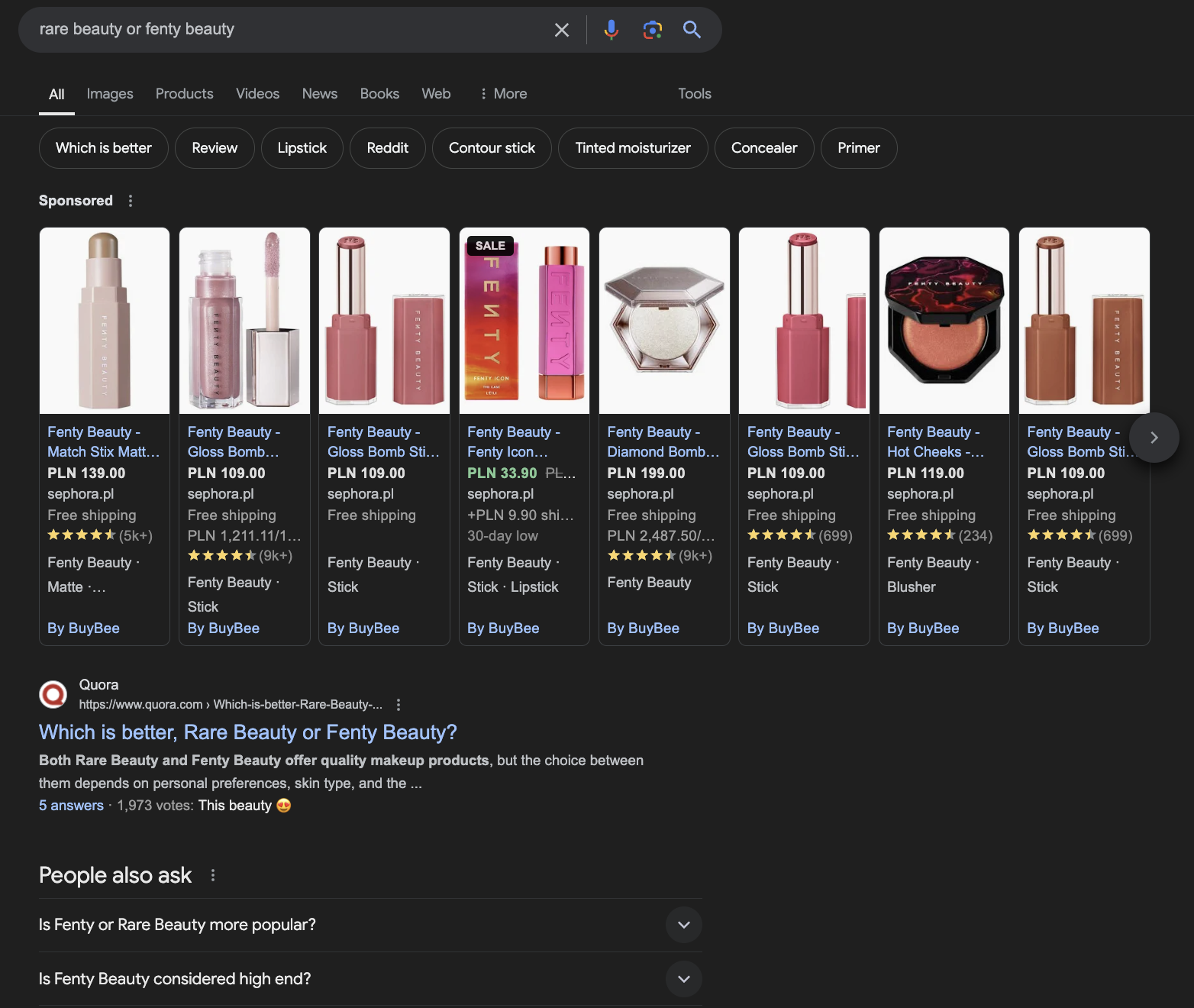
The result of such queries are not only product advertisements, but often opinion aggregators, thematic blogs or popular compilations and rankings.
What does Google say about this? Search intent in guidelines for raters
Search intent is a crucial factor in building high-quality Google search results. The importance of intent is addressed in the guidelines for raters from the Mountain View giant. In them, he breaks down the importance of queries, the intent of users, as well as links between other parameters like location.
Google’s search intent documentation identifies five general query types in the context of intent, each of which can be linked to the four aforementioned search types:
- Know simple / wants to know more precisely – these are exact queries, such as about the weather or a particular characteristic of a person; the result is often given using snippets with the answer in short form..
- Know / wants to know – these are classic informational queries, and they usually result in pages with a comprehensive answer.
- Visit-in-person / wants to visit this place in person – queries related to the location and service provided at a given location, i.e. mainly transactional in nature, but also informational or navigational.
-
Google’s guidelines indicate that intent can be multifaceted and that search results are also influenced by other user data, such as location or demographics. This approach is designed to best answer users’ queries. Consequently, the quality of SERPs (Search Engine Results Pages) improves, and the results increasingly feature rich snippets. Machine learning algorithms, such as BERT and RankBrain, play a key role in determining intent, effectively mimicking human thought processes and understanding user intent.
How to “sense” search intent in the SEO process?
Learning the theory behind search intent is the foundation in determining effective phrases and using them to build positions in search results. Here are ways to determine intent and set an effective path to SEO promotion..
1. “Ask the customer”.
The foundation of building any business is knowing the target customer. Even before creating the website itself, we should identify the persona that will be the target user of the site, and study their intention. .
How to use the customer to determine intent and use that in SEO?.
-
- Determine your KPIs and put yourself in the shoes of the customer – if your goal is to sell in an online store, try to find your product through a search engine and the path to purchase, record phrases and difficulties encountered.
- Suggest to your co-workers and friends – ask them to go through the same process as you did before, while making notes.
- Do A/B testing – test several variations of site navigation – such as a shopping path – and test on a specific audience.
- Gather feedback from customers – ask about impressions, ask how they arrived at your site, how they search for products and what they type into the search engine.
Once you have gathered sufficient intelligence, group key phrases and comments by purchase path or site interaction. These phrases can be categorized by intent, allowing you to build relevant content on the page. In addition to having SEO-ready keyword phrases, you’ll also have a clear strategy for improving the site’s user experience (UX).
2. Analysis of key phrases.
Search intent can be discerned through keyword phrase analysis, particularly when selecting long-tail keywords for promotion. By understanding the purpose behind a search—whether someone is asking questions or looking for a local restaurant—we can incorporate pronouns and refine short keyword phrases. A larger set of matching phrases increases the likelihood of improving the site’s visibility.
3. Analysis of search results.
Just enter a phrase into a search engine and we already have a clear answer as to how the user’s intent is evaluated by Google’s algorithms. Analysis of the blocks and sections appearing in the SERP for a given query will indicate the content or techniques to be implemented on the site..
Example for a query – how to make a pizza.
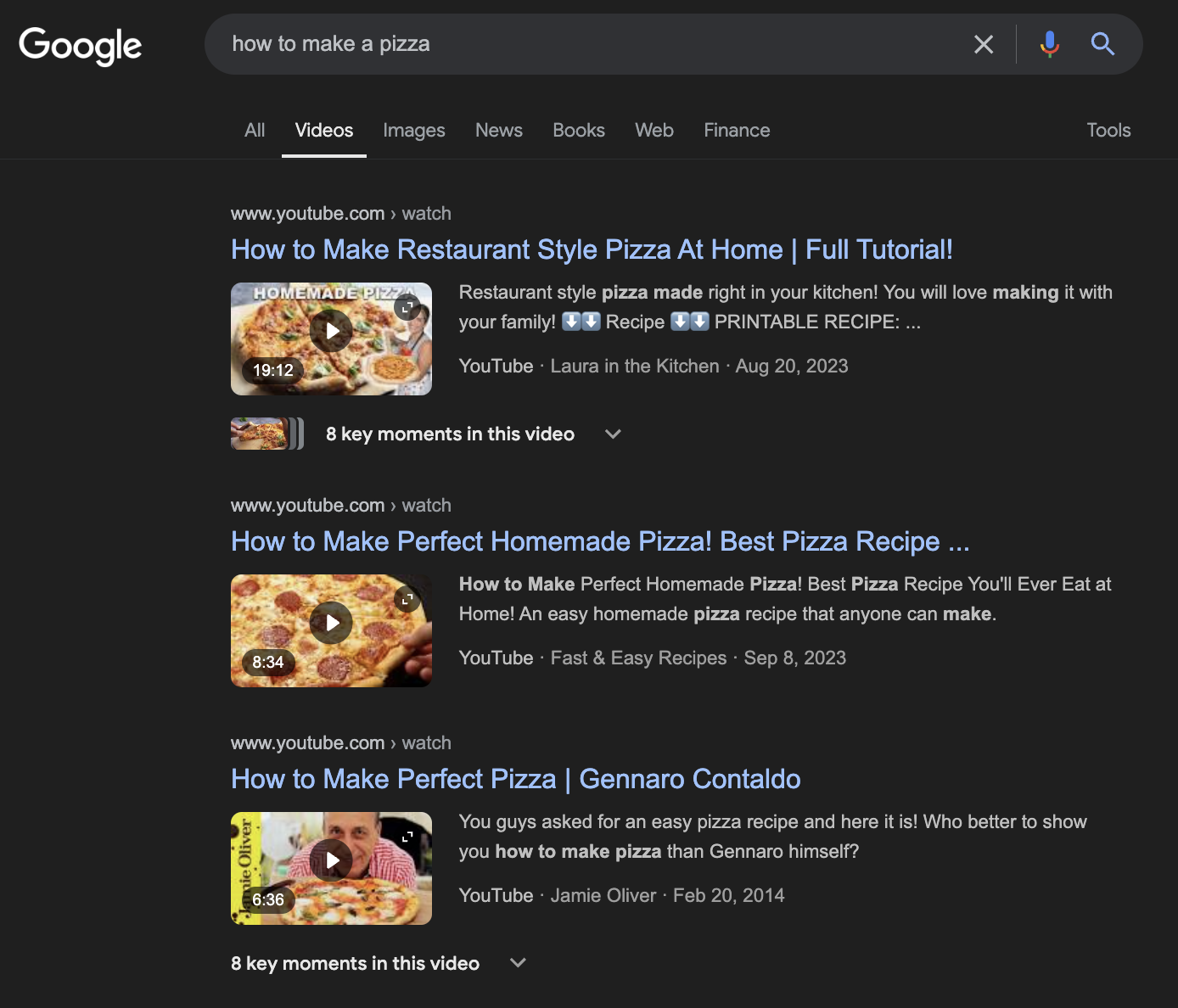
After analyzing the results and the phrase, we determine the search intent as “Know” (dominant), which can quickly expand to “To” (sufficient for the user to add video content, though it wasn’t necessary in this case). The nature of the query is informational. Google’s results include tutorials and pizza recipes. Additionally, the algorithms efficiently suggest a list of videos that demonstrate how to make pizza.
In the context of SEO, this indicates that we should focus not only on the content of the recipe itself but also on creating video content. We should use video titles as headlines or long-tail phrases to enhance the text version of the recipe. Complementing this study involves analyzing the competition and evaluating their choice of phrases and page structures. We check whether guides or product sub-sites are ranking for a given phrase; the prevalent type among the top 10 results should guide our promotion strategy.
4. SEO tool
When determining intent and selecting key phrases, commercially available SEO tools like Semrush or Senuto come in handy. In the Keyword Magic Tool from Semrush, with the help of filtering, we can divide phrases precisely in terms of intent, which we get as if on the palm of our hand. On the Polish market there is a solution from Senuto – Content Suite AI which will build a content plan taking into account the intent of the key phrases. Already at the phrase selection stage, the tool displays search intent, helps categorize articles and makes it easy to add or discard phrases before building a plan.
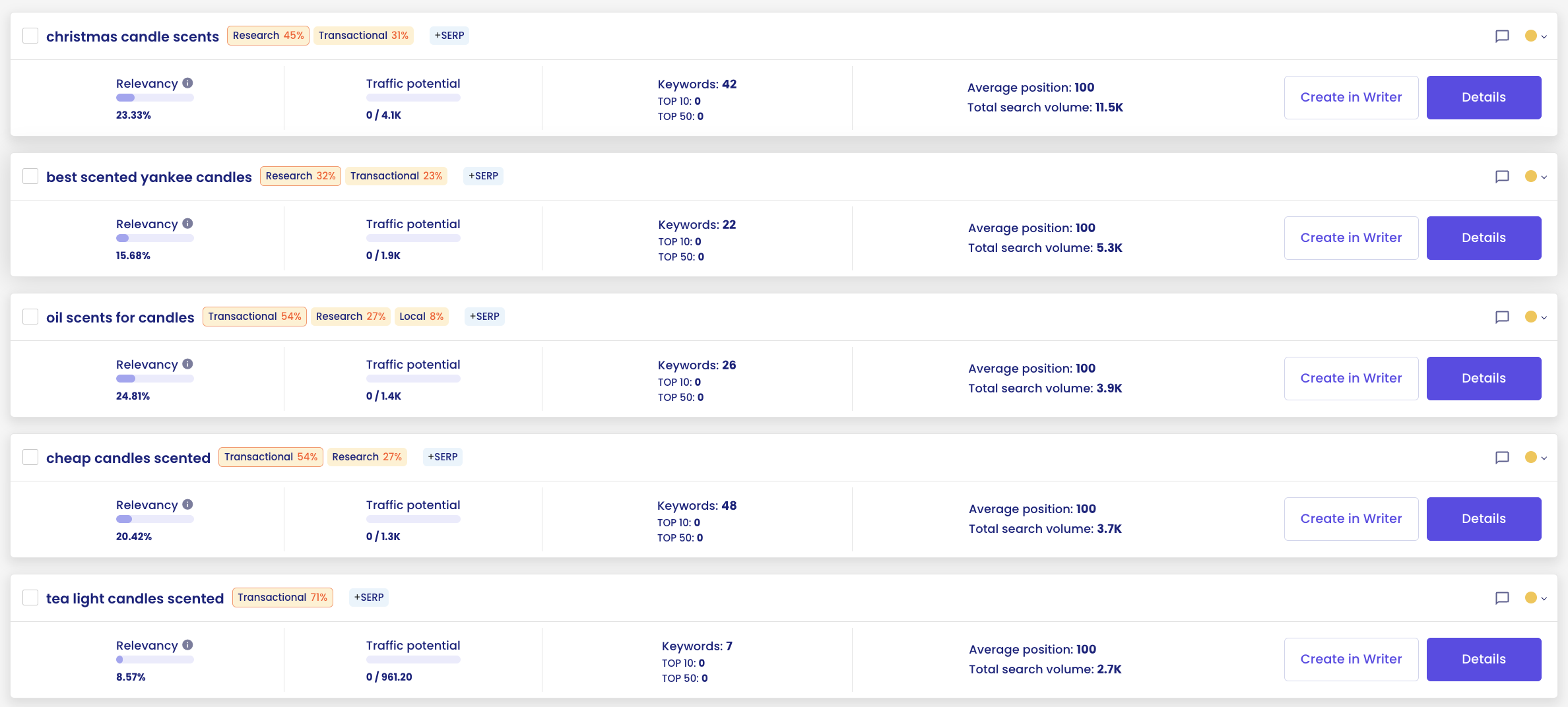
Senuto, in order to make phrases easier to understand, defines two additional intents compared to classic divisions. In addition to navigational and transactional there are:.
-
- Research – reference to informational intent, these are phrases that answer questions and the intent of knowledge seekers
- Local – expressions with local context, where search results also include Google maps
5 Ask ChatGPT.
If it’s trepidation, go to ChatGPT – a great benefit of using ChatGPT for choosing subject matter or key phrases is its artificial intelligence system, which is also used by search engines such as Google to determine search intent. All you have to do is create a query with a dose of intent knowledge and you get a ready-made list of phrases by intent or an index of topics for a blog. .
Remember to match these answers with your own knowledge or with other SEO tools. ChatGPT is still a tested solution, without Internet access, so let’s keep a proper distance. Let’s treat it as an assistant, not a substitute to do our jobs .
Search intent SEO – how does it help in the SEO process?
As you can see, search intent has a significant impact on the SEO process. Understanding search intent SEO enhances strategy planning, site development, topic clustering, and content planning. It also plays a crucial role in the later stages of promotion—analyzing SERPs and aligning a site with the latest search results is an ongoing task. Below are the areas of SEO particularly relevant to search intent.
Selecting phrases
According to the motto – how you make your bed, so you sleep. Choosing phrases and knowing your intentions is a key process in your site promotion strategy – if you get it wrong, it will affect every subsequent stage of SEO. What in particular to pay attention to when choosing phrases?.
-
- Determine the intent of the phrases and group them according to them (persona building will help).
- Based on general phrases from each group, build further longer long-tail phrases (don’t forget to use SEO tools).
- If your phrases are mainly informational, build a list of phrases that are questions by adding pronouns: “how,” “who,” “where.” – according to the topic of the site.
- Match the intent and phrases to the theme and type of subpage. A product page is always a landing page for a transactional intent, while a blog guide corresponds to an informational or commercial intent.
Content marketing
Determining the intent of a given sub-page significantly affects the type of content that should be included. After checking the types of pages in the top 10 in the competitive analysis, we select the appropriate forms of content. Of course, intent, phrases and content combine and work together for your effect..
How to do content matching in the context of intent? Here are some examples.
- Informational: is longer forms of text, descriptions and definitions of services, description of historical events company description or recipes.
- Commercial: are texts with reviews, rankings or popular FAQs with questions and answers.
- Transactional: comprehensive product descriptions, including graphics and video, technical specifications.
Note: You can mix content types as you like – just as user intent can mix. What type of content will be prepared depends on a full analysis of the site and the industry in the SERP for a given keyword phrase..
Thematic clusters
Understanding user intent helps in developing a targeted content promotion strategy, particularly through the use of topic clusters. As we create vast amounts of content, we eventually face the challenge of organizing and categorizing it into precise topic clusters. This approach is not only effective for SEO but also enhances user retention on the website. Knowing search intent facilitates the selection of key topics when building a pillar page. The design of these pages depends on the intent—whether it is informational or commercial. A well-chosen intent leads to more useful and readable topic clusters for users, which in turn generates relevant traffic from search engines.
Technical optimization
After determining the user’s intention, we should focus the technical work within the subpage 100% for the user’s convenience. Let’s make sure that the user gets the content in the right form. If he is looking for information, the text should have appropriate headings, posed questions and theses. On the other hand, for a person looking for a product, we make it easy to navigate, shorten the buying process. The user should feel at ease on our site, so that his intention is satisfied..
Don’t forget about search engine optimization. Let’s make sure the address and contact information are visible under phrases with intent visit-in-person. If someone is looking for a restaurant, the phone number and menu should be the most important sub-page content appearing in the ATF section (at first glance). Other aspects, such as the site’s loading speed, properly tailored graphics and, above all, structured data, will facilitate better understanding of the site by web bots and increase the chance of appearing in search results with a specific intent (e.g., through the previously mentioned rich snippets)..
E-commerce
This is a specific area related to transactional intent and is the subject of another comprehensive guide. Purchasing processes are also psychological processes, so it is essential to understand the potential customer thoroughly. In SEO, we must focus on product presentation, the purchase path, image optimization, and fundamental aspects such as appropriately named products and an optimal, logical category structure. An SEO specialist should also address the site’s background, ensuring its relevance and its ability to attract traffic from other intent types, such as commercial or informational. By doing so, we expand the opportunities and number of pathways to the site, ultimately enhancing the chances for higher conversions.
Benefits of search intent SEO
The benefits of understanding the user are enormous. Empathizing with your potential customers is an opportunity for success not only in sales, but also in SEO. Search intent will allow us to spread our wings and choose the right strategy direction..
What can we gain?.
-
- Conversion – if we empathize with the buyer’s intent, we will increase sales.
- Stability of results – in a long-term strategy, properly planned activities in terms of intent will keep us on top even longer.
- Growth of organic traffic – a greater number of properly targeted and ranking phrases is a chance for more organic traffic.
- Reduce bounce rate – a response properly crafted to the intent of the query will keep the user on the site.
- Satisfied user/customer who got to the site and achieved their goal.
User Interaction and SGE (Search Generative Expierence) Development
Google is working hard to develop its search engine and the use of AI – all in the service of the user. SGE is a completely new approach to displaying search results with AI generating answers, while keeping classic search results as a supplement in the form of a carousel and list of results. Of course, such changes will have a huge impact on SEO, but inconspicuously, it is the intent that may be the new key to success. .
They will greatly increase shopping or local intent, the results of which are likely to show up in position 0 – that is, right in Google’s quick response. Logically, information intent may undergo a transformation, which will be mainly based on AI response. This will change the approach to building content and thematicity of sites. At this stage, these are only theses, as SGE is still an experiment for a narrow range of users, however, the impact of user intent on the quality and appearance of search results will become increasingly important..
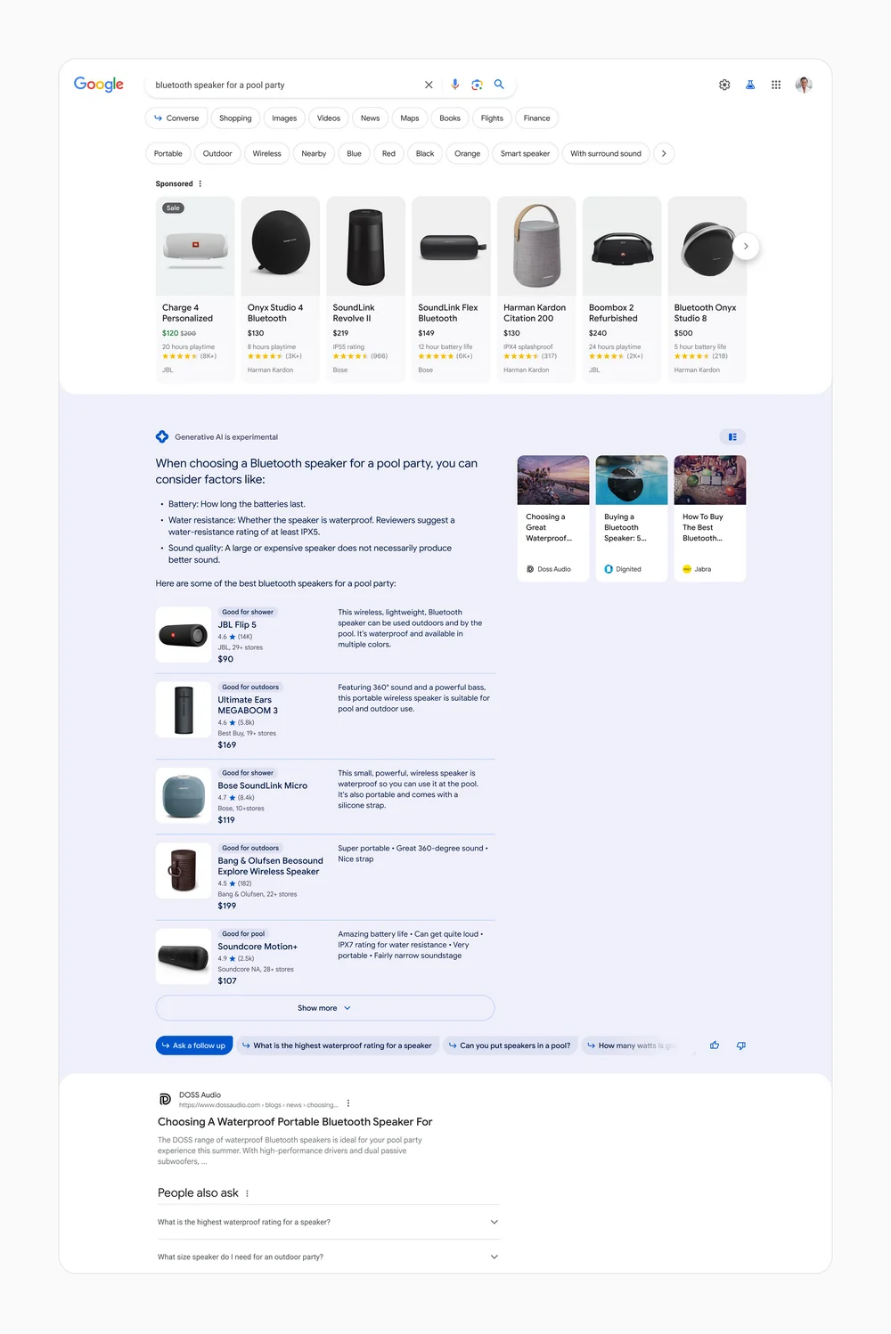
Is search intent the future of SEO?
The concept of search intent has been around for some time and will continue to play an important role in SEO. The increasingly popular artificial intelligence algorithms will not obscure the essence of search intent, but will further enhance it, as they will want to tap into the user’s emotions and needs. The repeatedly scrolling key phrases above will gradually lose their importance. They will continue to be the axis of work in optimizing many aspects of the site, but not the main focus. In search intent SEO, we should focus 100% on the user – take them on a journey through our site and provide the best possible experience. All this together is a ready recipe for success in the world of SEO..
 Bartłomiej Żydkiewicz
Bartłomiej Żydkiewicz